Trailer Brakes
Brakes add a whole new dimension to trailering, especially for those new to towing or those you have never experienced towing a braked trailer. As well as having the basic aspect of being able to slow down and stop without your fully loaded trailer shunting your tow vehicle into a dangerous situation, and being able to stop quickly in an emergency, having brakes fitted to your trailer allows you to safely tow heavier loads without having to upgrade your tow vehicle.
There are 3 types of braking methods – mechanical, hydraulic and electric. Mechanical and hydraulic brakes can be either disc or drum brakes and electric is solely drum brakes. The systems for how the brakes engage or are actuated can be mechanical, hydraulic, electrically operated or a combination of air and hydraulics or electricity and hydraulics depending on which braking method is required.
The guide below shows the combinations commonly used. In New Zealand you are legally able to use the override/surge mechanical/hydraulic (black & red arrows) and the on-trailer cab controlled electric (green arrow) methods on trailers up to 2500kg GVM and in Australia up to 2000kg GTM as long as the components are rated for their appropriate loads (see below for component rating information).
The cab controlled methods (yellow & purple arrows) are suitable for trailers from 2500kg, up to 3500kg GVM in NZ and from 2000kg up to 4500kg GTM in Australia. See “Legal Braking Requirements – NZ & Aust.” for more details.
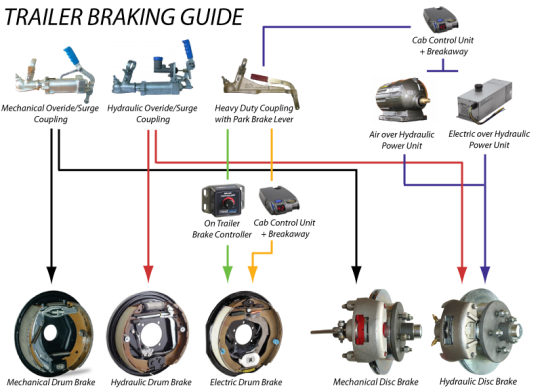
Trailer Component Ratings
Trailer components need to function as a whole to make the trailer suitable to carry specific loads safely. From the design of the chassis and drawbar, the spring and axle rating, the hubs, rims and tyres right through to the safety chains and shackles - all need to be matched to be rated equal or exceed the desired gross trailer loading. For example – it is folly to build a single axle trailer for 2000kg GVM/GTM and fit 1500kg rated hubs and stubs or 1000kg rated springs – its “Murphys Law” that the weakest part of your trailer will fail at the most inconvenient moment (think rainy night with a fully loaded trailer on the side of the road in the middle of nowhere). Always check the manufacturers recommended ratings for each component you fit to your trailer. The under-designed, un-rated or lowest rated component will always be the weakest link on your trailer - be wary of cheap or unbranded components.
Before fitting brakes to your existing trailer to increase its towing capacity, ensure that all the other components are up to the task.
Deciding which type of brakes comes down to a couple of factors.
• Size of the trailer and the maximum weight you need to carry
• Towing capacity of the tow vehicle and its towbar rating
• The size of your wallet
Override/Overrun/Surge Couplings
Override/Overrun/Surge couplings use a spring dampened movable coupling head which uses the tow vehicles momentum and braking to operate an attached lever or hydraulic master cylinder (a small manual hydraulic pump). The rearward movement of the coupling is transferred to the brake unit by cables/rods or hydraulic fluid depending on the setup. Override couplings are suitable for trailer braking up to 2500kg GVM (NZ) or 2000kg GTW (Australia) Click here for more information on Trailer Couplings.
Mechanical Override/Surge Braking
The most basic & cheapest type of braking is the mechanical override/surge coupling connected to mechanical drum or disc brakes. This type of braking is ideal for short haul highway or around town towing for loads up to 2000kg.
Mechanical brakes used with spring dampened override couplings tend to be harsh in their braking ability, they have a minimal amount of sensitivity to what the tow vehicle is doing and in most situations will be either off or on. The newer European hydraulic dampened override couplings with rod and cable activation overcomes this and gives smoother and sensitive braking more in tune with the tow vehicles braking, particularly with drum brakes.
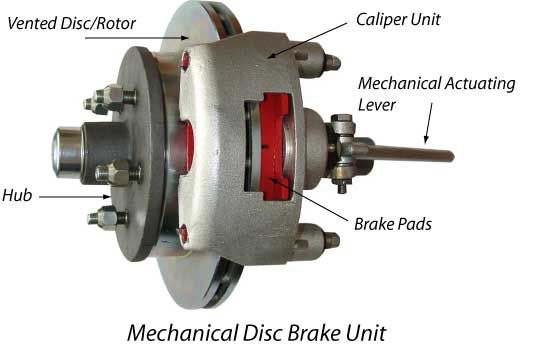
Connection between the coupling and brake is either cable or rod/cable and both need careful adjustment and regular attention to ensure that any wear in the caliper brake pads, stretch in the cable, or damage to the rod/cable setup is corrected. Failure to do so may cause the brakes to prematurely wear out or fail to operate correctly when required.
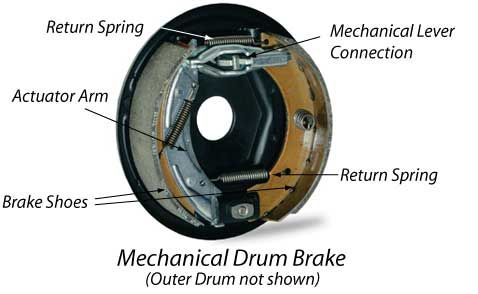
When towing with a cable only brake setup, the trailer hubs will be regularly moving up and down and in whichever direction your suspension is set to move. This movement causes the cables to slacken and tighten, and if incorrectly setup, your brakes will activate every time the cable tightens. As well as being uncomfortable to tow and increasing your fuel use, the brakes may overheat and shoes or calipers will quickly wear out. For this reason, cable operated brakes are not suitable for any off-road activity.
Mechanical disc caliper units come with either forward pull or centre pull systems for the cable to activate the brakes. Either system can be used, but forward pull is more common on a standard axle/spring setup with centre pull used on independent/torsion axle setups.
Hydraulic Override/Surge Braking
A step up from mechanical braking is hydraulic override/surge braking and overall this system is an improvement in both braking efficiency and control. The hydraulic master cylinder attached to the spring dampened coupling softens the impact of the coupling motion and gives a slightly more proportional amount of braking control.
Hydraulic drum brakes tend to have smoother braking over disc brakes, and this makes them especially suited to trailers where the cartage of livestock or fragile loads is undertaken.
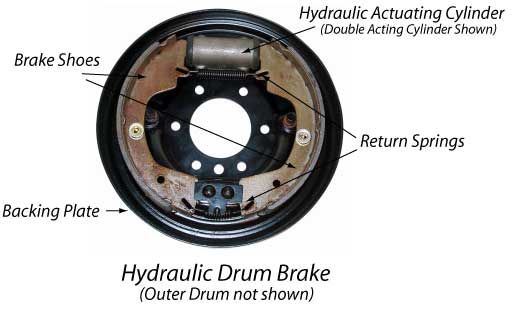
Drum brake load ratings are up to 2000kg per axle although 1750kg load rating is common. Disc brake load ratings range between 1500kg up to 2500kg per axle.
Hydraulic override/surge braking operating disc brakes are probably the most common type of braking on trailers up to 2500kg GVM (NZ) and 2000kg GTM (Aust.). They are easy to install and set up, require less maintenance than drum brakes and spare parts are readily available.
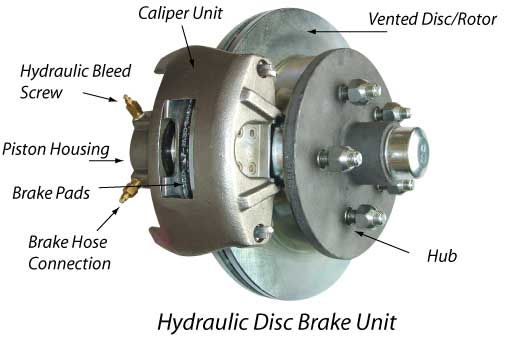
As with mechanical braking, if the newer European hydraulic dampened coupling is used, braking sensitivity is increased and braking of the trailer becomes more proportional to the tow vehicle for both drum and discs.
Electric Drum Braking
Electrically operated drum brakes are the most common type of drum brakes on trailers up to 3500kg GVM (NZ) and 4500kg GTM (Aust.).
They are activated via a brake controller - either trailer or tow vehicle in cab mounted (see below for more information) - which sends an electrical current (12volt) proportional to the amount of braking of the tow vehicle, down to an electromagnet within the brake. The electromagnet flings itself axially out to the inner surface of the drum while pulling an actuator arm attached to one of the brake shoes. The second shoe will follow suit almost instantly.
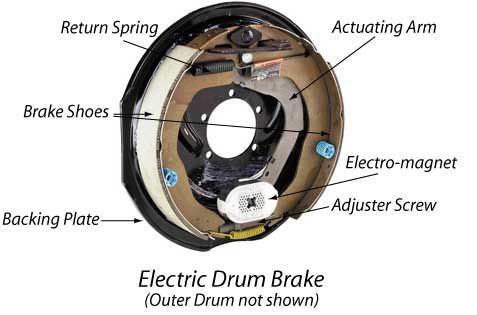
The advantage of electrically operated drum brakes is that because the input from the controller is precise (in cab), the amount of control over the trailer is enhanced whether the trailer is empty or full and gives exceptionally smooth and proportional braking.
Most electric drum brakes have the option of a mechanical park brake lever within the units.
If you are towing off road or regularly towing over rough roads, specially designed off road electric brake drum units are available. The electro magnets are built with wear resistant plastic inserts to prevent premature failure and the shoe material is designed to cope with dusty environments and the increased heat that this generates more efficiently. Electric drum brakes are unsuitable for boat trailers or prolonged submersion in water.
Again, correct setup and regular maintenance is paramount to ensure reliable and trouble free operation.
Electric Drum Brake Controllers
If you are fitting electric drum brakes to your trailer, the brakes will require a controller which send an electrical voltage to turn the brakes on and off at the right time, as well as regulating how much braking is required.
There are two types of controllers available – Time Delayed & Proportional Control
Time Delayed Brake Controllers
Time delayed controllers are the most basic of the two controllers and are relatively cheap to purchase and easy to fit.
When the tow vehicle brakes are applied the controller gets a signal from the tow vehicles brake lights and then sends a pre-determined amount of power (manually set prior to towing based on trailer weight) to the trailer brakes. There is then a timed delay to allow the braking effect to ramp up to full braking power (normally less than 1 second )
In cab and trailer mounted units are available. The trailer mounted units, being an indirect braking system, can only be used on trailers up to 2500kg GVM (NZ) and 2000kg GTM (Aust.) They are easy to mount and can be positioned anywhere on the trailer that is protected and easily accessible.
One of the problems with having the unit mounted on the trailer is that it is easy to forget to adjust for whatever load you are carrying. If you are towing an empty trailer with the controller set on maximum, when you apply the brakes, your trailer brakes can potentially lock up resulting in smoky tyre tracks down the road. Worse still, having the controller set to minimum carrying a full load may prevent you from stopping safely, with the potential for a nasty accident.
In cab time delayed controllers which are fitted within easy reach of the tow vehicles driver, prevent this happening, as braking adjustment for load and weather conditions can be made on the move. Most in cab time delayed controllers have a manual slide knob for applying the brakes in an emergency/panic situation.
Proportional Brake Controllers
Proportional controllers use an electronic pendulum or inertia device to detect the tow vehicles motion. While stationary or under normal forward motion, the pendulum will be in a vertical or rearward position. When the tow vehicle decelerates or slows down, the pendulum will swing forward, and depending on the amount of forward swing, the controller will apply a proportionate amount of voltage to the trailer brakes.
As the tow vehicle brakes, the controller will apply the same amount of braking pressure to the trailer brakes. If the tow vehicle brakes are fully applied, the trailer will have full braking power. This matching of the tow vehicle and the trailer has many advantages over time delayed braking and surge braking.
Proportional braking varies the amount of braking power according to the tow vehicles actual deceleration and results in smooth, precise and controlled braking of the trailer. Time delayed controllers will always send the same, set amount of power to the brakes, causing either the tow vehicle or trailer to brake harder and heavier. Premature wear and tear of the brakes is increased but with proportional control, the wear is spread evenly between the vehicles.
There are a couple of differing methods for the controller to sense the tow vehicles deceleration through braking. One popular system replaces the tow vehicles brake pedal rubber covering with a pressure sensitive pad. When the brake pedal is depressed, the pad senses the amount of foot pressure that is applied and the controller sends the appropriate amount of power to the brakes.
Another system has a sensor physically connected into the tow vehicles hydraulic brakes system. Again, as the tow vehicles brakes are applied, the sensor detects the brake fluid pressure and sends an electrical current via the controller to the brakes proportional to the tow vehicle.
As you can imagine these systems are quite expensive to purchase and fit and have the drawback of being fitted to one dedicated tow vehicle. These dedicated systems do have the edge over standard pendulum/inertia controllers. They exactly replicate the tow vehicles braking to the trailer and are not affected by differing road gradients and conditions as pendulum/inertia controllers can be.
Travelling over undulating, steep and winding roads, including gravel roads can affect the action of a standard inertia controller, causing it to apply brakes or to apply too much braking when minimal braking or no braking is required.
Most proportional controllers have inbuilt display screens showing the amount of voltage being applied to the brakes and the fancier models have fault and diagnostic information available.
All proportional controllers have an emergency/panic slider to allow the driver to manually apply the brakes if required. This is particularly useful if your trailer is prone to “trailer sway” and enables the brakes to be applied to the trailer only, and hopefully getting the trailer corrected quickly and safely.
In cab proportional controllers are the only system suitable for trailers over 2500kg GVM (NZ) and 2000kg GTM (Aust.) and are normally used for trailers fitted with electric drum brakes.
Some late model commercial vehicles/utilitys have wiring for brake controllers already installed and is just a matter of plugging the controller in. There are also vehicles out there with brake controllers built into the vehicle with all the controls mounted into the dash.
As shown in the “Trailer Braking Guide” above, there is the option of fitting hydraulic disc brakes to a trailer over the 2500kg/2000kg threshold (purple arrows), if an electric over hydraulic (EOH) or air over hydraulic (AOH) actuator is installed on the trailer. These can also be used to actuate hydraulic drum brakes, but is very uncommon.
Electric over Hydraulic Brakes (EOH)
An electric over hydraulic unit is a self-contained electrically operated pump/hydraulic reservoir which sits on the trailer (normally mounted centrally at the front of the trailer drawbar behind the coupling).
When the in cab proportional controller detects vehicle braking, it sends a signal to the electric pump which pumps hydraulic fluid to the brakes at the correct pressure to match the tow vehicles deceleration.
Electric over hydraulic controllers are commonly becoming mobile and easily transferred between tow vehicles. They simply plug into the cigarette lighter socket, self level and calibrate themselves and can be positioned on the dashboard or drivers lap as required. They normally have all the bells and whistles of the top end fixed controllers with the convenience of being able to use multiple vehicles to tow the trailer.
With all trailer based electrical equipment which predominately operates at 12 volts, check your tow vehicle voltage output matches the equipment you are purchasing. If you vehicle runs 24 volts, it would be prudent to check and take advice from your local auto electrician before installing 12 volt equipment.
Air over Hydraulic Brakes (AOH)
Air over hydraulics are similar to the EOH method of braking, but use compressed air to pump hydraulic fluid to the brakes. Air over hydraulic systems are operated via pressure sensitive brake pedal activated controllers (see above).
When the trailer is initially hooked up to the tow vehicle, the in-built compressor starts up and builds up a store of compressed air within its housing. When the driver applies pressure to the brake pedal, the controller releases the stored air pressure to the hydraulics giving almost immediate braking power to the disc brakes.
Air over hydraulics have a slight edge over EOH as the brakes are applied almost instantly where the EOH has a slight delay (up to one second) while building up brake pressure.
The great thing about using an EOH/AOH hydraulic braking system over electric drum brakes for trailers over the 2500kg (NZ)/2000kg (Aust.) threshold is that you have all the control, response and stopping power of electric brakes, but with the advantage of lower maintenance requirements and the ability to use the trailer brakes in both wet and marine applications.
Both EOH and AOH braking systems are expensive to purchase and install, but if you are planning on keeping the trailer for an extended period of time, do a lot of long distance hauling or everyday travelling with full loads, have limited downtime for maintenance or have a trailered boat that exceeds the 2500kg/2000kg threshold, then fitting either of these options is highly recommended.
Breakaway Brakes
Breakaway brake units are designed to immediately apply full braking power to the trailer brakes should the trailer separate from the tow vehicle.
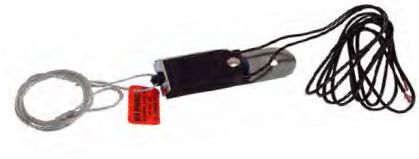
The box is mounted on the trailer drawbar and the tether fitted to the tow vehicle with a shackle or hook.
A small rechargeable battery on board the trailer supplies power to the breakaway box and when the pin is pulled from the box (when the trailer comes away from the tow vehicle) full power is instantly applied to the brakes.
Power is supplied to the brakes until the on board battery runs out of juice or the pin is re-fitted to the breakaway box.
It does pay to regularly check the battery charge especially when the trailer is infrequently used. If this is the case, remove the battery and charge it on a mains charger before any trips. Also check that the tow vehicle is charging the battery when plugged into the trailer.
To check if the breakaway unit and battery are working correctly, immobilize the trailer and jack the wheels up. Pull the breakaway pin while a mate spins the wheels. They should lock up immediately.
The breakaway tether needs to be attached to the tow vehicle and not to the chains, the chains will not pull the breakaway pin out if the trailer decides to part company. Likewise the tether needs to be in good condition and needs to be replaced if kinked, frayed or damaged. If the damaged section fails before the breakaway pin can be pulled, the brakes will not come on.
Breakaway brakes should not be used as a park brake as the battery will quickly lose its charge and the brakes will release.
Drum Brakes
Drum brakes consist of a backing plate which is bolted onto a fixed plate on the stub axle. The backing plate contains the brake shoes, levers/springs and the actuating method for operating the brakes (mechanical lever, hydraulic cylinder, or electro magnet). The drum itself is a heavy casting which provides the friction surface for the brake shoes and contains the bearings and seals as well as the studs for mounting the wheel.
When braking occurs, the actuator pushes the brake shoes outwards to contact the spinning drum. The friction between the brake shoes and the drum slows or stops the trailer.
Drum brakes, due the way the shoes have contact with the circumference of the drum will normally provide more braking force than the same diameter disc brake. The disadvantage is that drum brakes produce and retain more heat during braking, and are more complicated to setup and maintain than disc brakes, They are often cheaper to purchase and are normally more powerful than their counterparts. Drum brakes also require less space than disc brakes and can assist in reducing the overall width of a trailer if it is bordering on its legal maximum.
Drum brakes have a natural tendency to self energise, where, during normal operation, the spinning of the drum can draw the brakes shoes closer to the surface of the drum. Under braking, the shoes bite harder into the drum and can provide increased braking power. This characteristic of self-energizing also makes the drum brakes more susceptible to “brake fade” which is a reduction in brake friction under heavy braking. Under normal conditions this would not be an issue, but if towing heavy loads down steep inclines or where sustained braking is needed, high temperatures within the drum will cause the brakes to “soften” and become less reliable.
Once cool, the brakes will return to their normal state, but it would pay to remove the drum and check the condition of the brake shoes. If any glazing has occurred, use a fine grit emery cloth to sand the shoes gently and replace the shoes if they showing signs of wear or damage. Drum brakes also have another drawback which is quite the opposite to “brake fade” and that is when the brakes are cold and damp or if there is any rust forming on the drum. In these circumstances, the brake shoes can “grab” onto the drum and can cause the wheels to skid even when no brake pressure is applied.
The situation may resolve itself quickly depending on the weight of the trailer and the road surface, or, due to the self-energizing characteristic of the shoes, may intensify the problem to the point where you need to get down on your hands and knees to pull the unit apart and remedy the problem. However, drum brakes are still the brake of choice for many trailers, especially electrically operated units on trailers over 2500kg GVM (NZ) and 2000kg GTM (Aust.).
The key to using drum brakes is to ensure that they are setup exactly to the manufacturer’s recommendations and that you check and maintain them on a regular basis, especially if they are operating close to or at their rated limits.
Drum brakes come in a range of diameters and their braking power increases as their diameters get larger. Before selecting drum brakes, ensure that the brake drum unit will fit within the trailers wheel rim.
Disc Brakes
Disc brakes are composed of a hub and attached disc or rotor, with a separate caliper unit which bolts onto the trailer axle. Within the caliper, brake pads sit either side of the disc/rotor and to put it simply, squeeze the disc by either mechanical or hydraulic power.
As with drum brakes, disc brakes have greater braking torque as they increase in diameter. As a rough guide, for every 1% increase in disc diameter, the braking efficiency increases by 1% due to the leverage gained as the caliper moves away from the axle. Larger diameter brakes also allow better dissipation of heat generated from heavy or constant braking.
Ideally the best braking comes from bigger rotors and the appropriate caliper piston to force it against the rotor. Calipers come in many options with single or multiple piston arrangements, cast iron, alloy or stainless bodies, differing piston materials from phenolic compounds, brass, or stainless and even the option of fitting a manual handbrake system to the calipers. Just make sure that the caliper, rotor and axle yoke are all compatible.
NOTE – When purchasing always make sure that the stub axle is matched to the rotor and caliper setup as the yoke design is normally caliper/rotor specific.
The load rating for disc brakes range from 1500kg to 2500kg per axle and have larger bearing arrangements and larger rotors as the load capacity increases. Caliper sizes normally remain the same across the range although on the heavier duty models there is sometimes the option of a double yoke axle for fitting an additional caliper. (You will need to upgrade to a larger master cylinder reservoir on your coupling.if more than one set of calipers are used)
NOTE - It is a good idea to take your wheel rim along to the supplier and do a dry setup of the hub/rotor and caliper before purchasing, to make sure that there is sufficient clearance within the rim.
Different suppliers will offer choices of fully cast one piece rotor and hub which are reasonably cheap to purchase and they have the advantage of being robust, have some cooling capacity due to an air gap between the rotor and the bearing enclosure and being readily available. The rotor can be machined if it gets damaged, pitted or scoured although your trailer will be off the road while this is being done.
More commonly available now are bolt on rotors which are a little more expensive to purchase but have quite a few advantages.
Depending on the brand, vented rotors (to assist in keeping the rotor/calipers and hubs cool) are available and rotors also come in various materials from cast iron, stainless steel and bronze. The latter two rotor materials are more suitable for marine applications such as boat trailers.
If the rotors are damaged or scoured, they are easily replaced or removed for machining.
Various stud patterns are available to suit most common rims and blank hubs (undrilled) are also available. Hubs are also available either in bare steel, painted, zinc plated and galvanised and for most applications either zinc plated or galvanised are recommended.
Hydraulic disc brakes are one of the most dependable braking systems available, and are simple to maintain and repair as long as they are looked after and treated with a little care. Disc brakes are the perfect brake for boat trailers, although regular cleaning and maintenance is required.